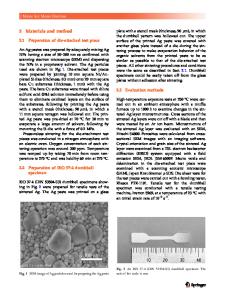Microstructure and properties of pressureless sintered ZrC-based materials
- PDF / 755,850 Bytes
- 8 Pages / 612 x 792 pts (letter) Page_size
- 38 Downloads / 321 Views
ZrC-based composites were produced by pressureless sintering thanks to the addition of MoSi2 as sintering aid. After preliminary tests, a baseline ZrC material and two mixed ZrC–HfC and ZrC–ZrB2 composites with 20 vol% MoSi2 were densified at 1900 to 1950 °C reaching final relative densities of 96%–98%. Mean particle size of the dense bodies ranged from 5 to 9 m. Secondary phases were found to form during sintering, such as SiC and Zr–Mo–Si-based compounds. Room-temperature mechanical properties were in the range of the values reported in the literature for similar materials densified by pressure-assisted techniques. The flexural strength was tested at room temperature, 1200 and 1500 °C.
I. INTRODUCTION
Zirconium carbide (ZrC) is a transition metal carbide characterized by some excellent properties such as high melting point (∼3420 °C),1 high hardness (∼25.5 GPa),1 high electrical conductivity (78⭈10−6 ⍀⭈cm), and high modulus of elasticity (∼440 GPa).1 ZrC is suitable for electronic applications (as thermoionic emitters) and nuclear applications (as diffusion barrier for fission metals in the coatings of nuclear fuels).2,3 However, barriers to its use are the poor resistance to oxidation and a costeffective manufacturing process for obtaining near-netshape components. A brief summary of the state of the art is first reported. ZrC powders were densified by Barnier et al. up to 98% of relative density by conventional hot pressing at 2300 °C, 40 MPa of applied pressure, and 60 min of holding time.3 Min-Haga et al. showed that mixtures of ZrC with 20–40 wt% ZrO2 were sintered to near theoretical density at temperatures 艌2000 °C in a graphite furnace and developed a homogeneous microstructure, caused by the formation of a defective oxycarbide that enhanced diffusion and densification in the carbide matrix.4 These composites had a four-point bending strength of 220 to 320 MPa and a fracture toughness of 4 to 5.8 MPa⭈m1/2, caused by the presence of tetragonal zirconia that generated toughening residual stresses.4 Ryu et al. tried to obtain dense ZrC composites through addition of 20 wt% Dy2O3, but the relative density after spark plasma sintering at 1727 °C was only 68% of the theoretical value.5 The addition of ZrB2 was reported to
II. EXPERIMENTAL
a)
Address all correspondence to this author. e-mail: [email protected] DOI: 10.1557/JMR.2008.0234 1882
http://journals.cambridge.org
enhance the densification of ZrC as composites with low residual porosity (2%–4%) were obtained after thermal treatment at 2100 °C for 2 h.6 Tsuchida and Yamamoto prepared a ZrB2–ZrC composite by mechanically activated self-propagating high-temperature synthesis of a Zr/B/C powder mixture that was subsequently consolidated by spark plasma sintering at 1800 °C; the composite had a hardness of 17.8 GPa and a fracture toughness of 3.8 MPa⭈m1/2.7 Kim and Shim added 3 wt% of La to the eutectic composition ZrB2:ZrC ⳱ 59.9:40.1 wt% and obtained a relative density of 99% by spark plasma sintering at 1750 °C.8 Lanthanum was confirmed to ac
Data Loading...









